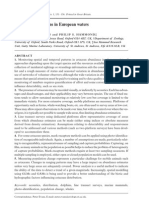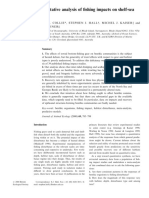CF 6
CF 6
Uploaded by
Kuys XeeeCopyright:
Available Formats
CF 6
CF 6
Uploaded by
Kuys XeeeOriginal Title
Copyright
Available Formats
Share this document
Did you find this document useful?
Is this content inappropriate?
Copyright:
Available Formats
CF 6
CF 6
Uploaded by
Kuys XeeeCopyright:
Available Formats
There is a growing body of evidence that weasel species are in decline globally.
More data on their ecology and distribution are needed to plan and justify any
conservation management actions. Camera trapping can be an effective survey
method for many species; however, the small size and quick movements of weasels
present challenges in detection and little consensus exists on practices for attracting
them to improve detection. This study tested different combinations of meat baits
and scent and audio lures to assess the most effective methods. Camera traps were
set up in clusters of three at 42 sites to test the effectiveness of these combinations,
accounting for season, in terms of the time to first detection (TFD), detection
probability using occupancy models, and the number and clarity of weasel photos.
We also repeated TFD and detection probability analyses for setups that were ≥
20 m apart in case of overlap of effects. The average TFD across all sites was
43 days. Fall typically had the shortest TFD with beaver bait in fall achieving the
best results. After accounting for occupancy, predicted detection probability across
a 60-day survey was highest in fall with the best combination being salmon lure
and beaver bait. The treatment type did not impact the average number of photos
captured, but the clarity of photos was significantly positively related to use of bait
and lure, type of lure, and specific combinations of bait and lure.
You might also like
- BIOL415 Summary&CritiqueDocument3 pagesBIOL415 Summary&CritiquehanahackbuschNo ratings yet
- Kery 2002Document10 pagesKery 2002Reyna GutiérrezNo ratings yet
- Afandi s2Document11 pagesAfandi s2purwatiningsih.fmipaNo ratings yet
- DNA MetabarcodingDocument2 pagesDNA Metabarcodingiqra3242No ratings yet
- Biology LabDocument3 pagesBiology LabramsaykrisinaNo ratings yet
- JZO 2020 Tourani EtalDocument13 pagesJZO 2020 Tourani EtalJoana FerreiraNo ratings yet
- American J Phys Anthropol - 2018 - Allan - What Have We Been Looking at A Call For Consistency in Studies of PrimateDocument19 pagesAmerican J Phys Anthropol - 2018 - Allan - What Have We Been Looking at A Call For Consistency in Studies of Primatefabio nascimentoNo ratings yet
- Behavioral Sampling in The Field: Continuous Focal Versus Focal Interval SamplingDocument30 pagesBehavioral Sampling in The Field: Continuous Focal Versus Focal Interval SamplingKeila ZachéNo ratings yet
- WhalesDocument13 pagesWhalesMarielita CepedaNo ratings yet
- Amir New Intro (1)Document38 pagesAmir New Intro (1)Dr. Sardar Azhar MehmoodNo ratings yet
- DNA Barcoding and Metabarcoding of Standardized Samples Reveal Patterns of Marine Benthic DiversityDocument17 pagesDNA Barcoding and Metabarcoding of Standardized Samples Reveal Patterns of Marine Benthic DiversityJennifer SilvaNo ratings yet
- Muestreo Anfibios y ReptilesDocument28 pagesMuestreo Anfibios y ReptilesHector CardenasNo ratings yet
- Sampling Interval For Measurements of Estuarine Dolphins' (SotaliaDocument5 pagesSampling Interval For Measurements of Estuarine Dolphins' (SotaliasotaliaNo ratings yet
- Aylesworth, L., Loh, T.-L. ., Rongrongmuang, W., & Vincent, A. C. J. (2017) - Seahorses (HippocampusDocument11 pagesAylesworth, L., Loh, T.-L. ., Rongrongmuang, W., & Vincent, A. C. J. (2017) - Seahorses (HippocampusCharles GleanNo ratings yet
- Temporal Variation in Arthropod Sampling Effectiveness: The Case For Using The Beat Sheet Method in CottonDocument15 pagesTemporal Variation in Arthropod Sampling Effectiveness: The Case For Using The Beat Sheet Method in CottonCHRISTILANE MCKELLY BRADLEYNo ratings yet
- Catch and Release LabDocument3 pagesCatch and Release Labapi-276987199No ratings yet
- Alldredge Et Al 2007Document13 pagesAlldredge Et Al 2007erodriguezrNo ratings yet
- Mann-1999-Marine Mammal ScienceDocument21 pagesMann-1999-Marine Mammal ScienceLUCAS GARCIA MARTINSNo ratings yet
- Marine ThesisDocument8 pagesMarine Thesisbk3q07k5100% (2)
- Ferreretal 2007Document11 pagesFerreretal 2007YoshioNo ratings yet
- NASBR Final Abstracts 181003 PDFDocument98 pagesNASBR Final Abstracts 181003 PDFJose Juan FloresNo ratings yet
- 2021 Conhecimento Local Survey e Estimativa de Vida Selvagem AM PeruDocument14 pages2021 Conhecimento Local Survey e Estimativa de Vida Selvagem AM PeruAlessandro OliveiraNo ratings yet
- The Relationship Between Group Size and Vigilance While EatingDocument22 pagesThe Relationship Between Group Size and Vigilance While EatingDionne Angela Donnelly67% (3)
- Using Thermal Infrared Cameras To Detect Avian Chicks at Various Distances and Vegetative CoveragesDocument13 pagesUsing Thermal Infrared Cameras To Detect Avian Chicks at Various Distances and Vegetative CoveragesTinuszkaNo ratings yet
- Ries Behavioral Ecology ReportDocument9 pagesRies Behavioral Ecology ReportCollin RiesNo ratings yet
- Inventions: A Versatile Setup For Measuring Multiple Behavior Endpoints in ZebrafishDocument16 pagesInventions: A Versatile Setup For Measuring Multiple Behavior Endpoints in ZebrafishKarthik ManiNo ratings yet
- 10 1002@ecy 3117Document8 pages10 1002@ecy 3117giovanemazottiNo ratings yet
- Croft Etal JFB 2004Document5 pagesCroft Etal JFB 2004bombilla1No ratings yet
- Environmental DNA To Investigate Mammalian EcologyDocument4 pagesEnvironmental DNA To Investigate Mammalian EcologyRehan ZahidNo ratings yet
- A Discussion About QuadratsDocument5 pagesA Discussion About QuadratsramsaykrisinaNo ratings yet
- Sampling Methods For AmphibiansDocument39 pagesSampling Methods For AmphibiansBenzu Shawn100% (1)
- Coddington Et Al Des TestSampProt91 PDFDocument33 pagesCoddington Et Al Des TestSampProt91 PDFStefan Ribeiro DiasNo ratings yet
- Mark Rec103Document6 pagesMark Rec103Alief Tian Edo PramonoNo ratings yet
- Skalak MetEcoEvo2012-1Document13 pagesSkalak MetEcoEvo2012-1Raul Andres RodriguezNo ratings yet
- Evans and Hammond 2004Document26 pagesEvans and Hammond 2004api-3828346No ratings yet
- 2 Large Brown Tree Frog Survey Standards FINALv1.0 2MAY11Document7 pages2 Large Brown Tree Frog Survey Standards FINALv1.0 2MAY11Isnin NoerNo ratings yet
- What Is The Required Minimum Landscape Size For Dispersal StudiesDocument8 pagesWhat Is The Required Minimum Landscape Size For Dispersal StudiescarooplNo ratings yet
- Biol3006 Acamms Proposal 2014Document10 pagesBiol3006 Acamms Proposal 2014api-269588178No ratings yet
- BarbourGerritsen 1996 Subsampling JNABSDocument8 pagesBarbourGerritsen 1996 Subsampling JNABSFon “Fon” Nebra CostasNo ratings yet
- Rich Et Al-2017-Global Ecology and Biogeography PDFDocument12 pagesRich Et Al-2017-Global Ecology and Biogeography PDFPurwantoNo ratings yet
- Vaquita Expert Elicitation 2021 Report Final No LocationsDocument34 pagesVaquita Expert Elicitation 2021 Report Final No LocationsAbisme guiesNo ratings yet
- Latitude and Rates of Diversi®cation in Birds and Butter IesDocument6 pagesLatitude and Rates of Diversi®cation in Birds and Butter IesMaría Fernanda TorresNo ratings yet
- PCX - Report DiptyDocument25 pagesPCX - Report DiptySaurabh SinghNo ratings yet
- Effect of The Cleaner Fish Labroides Dimidiatus OnDocument8 pagesEffect of The Cleaner Fish Labroides Dimidiatus OnJessye Maria Deanne AwuyNo ratings yet
- Lee 1989Document4 pagesLee 1989Jacqueline SánchezNo ratings yet
- Species Diversity and Spatial Structure of Intertidal Mollusks in Padada, Davao Del Sur, PhilippinesDocument10 pagesSpecies Diversity and Spatial Structure of Intertidal Mollusks in Padada, Davao Del Sur, PhilippinesYayan MardiansyahNo ratings yet
- Endoscopyinsharks: Michael J. MurrayDocument13 pagesEndoscopyinsharks: Michael J. MurrayDaniela Peña VinascoNo ratings yet
- Alibhai The Challenge of Monitoring Elusive LaDocument22 pagesAlibhai The Challenge of Monitoring Elusive LaCippalippaNo ratings yet
- Anfibia 1Document8 pagesAnfibia 1labraxaslNo ratings yet
- Detection Dogs Allow For Systematic Non-Invasive Collection of DNA Samples From Eurasian LynxDocument5 pagesDetection Dogs Allow For Systematic Non-Invasive Collection of DNA Samples From Eurasian Lynxsusey madelit apaza mamaniNo ratings yet
- Responses of Wild Titi Monkeys Callicebus Coimbrai To The Habituation ProcessDocument6 pagesResponses of Wild Titi Monkeys Callicebus Coimbrai To The Habituation ProcessDavi FragosoNo ratings yet
- Symbiotic Association Between Caprellids (Amphipoda: Caprellidae) and The Scorpionfish Scorpaena Mystes (Pisces: Scorpaenidae)Document6 pagesSymbiotic Association Between Caprellids (Amphipoda: Caprellidae) and The Scorpionfish Scorpaena Mystes (Pisces: Scorpaenidae)CRISTIAN MOISES GALVAN VILLANo ratings yet
- Volume 42 1 97 3simpanzeDocument9 pagesVolume 42 1 97 3simpanzeAnindyaMustikaNo ratings yet
- Billock DissertationDocument162 pagesBillock DissertationThunderlord ZinogreNo ratings yet
- 2012 SCCS BLR Abstract BookDocument87 pages2012 SCCS BLR Abstract BookSurendra Bam100% (1)
- 1985 WrightDocument8 pages1985 Wrightavalosfrancia93No ratings yet
- Acoustic - Indices - For - Biodiversity - Assess20160224 16595 14xl80b With Cover Page v2Document11 pagesAcoustic - Indices - For - Biodiversity - Assess20160224 16595 14xl80b With Cover Page v2Jose Luis Perez GonzalezNo ratings yet
- Journal of Animal Ecology - 2001 - Collie - A Quantitative Analysis of Fishing Impacts On Shelf Sea BenthosDocument14 pagesJournal of Animal Ecology - 2001 - Collie - A Quantitative Analysis of Fishing Impacts On Shelf Sea BenthosVaibhavNo ratings yet
- Life History and Ecology of the Five-Lined Skink, Eumeces fasciatusFrom EverandLife History and Ecology of the Five-Lined Skink, Eumeces fasciatusNo ratings yet
- Amp 4Document1 pageAmp 4Kuys XeeeNo ratings yet
- Amp 3Document1 pageAmp 3Kuys XeeeNo ratings yet
- CF3Document1 pageCF3Kuys XeeeNo ratings yet
- Virtual Reality EnvironmentDocument1 pageVirtual Reality EnvironmentKuys XeeeNo ratings yet
- Robotics 4Document1 pageRobotics 4Kuys XeeeNo ratings yet
- Result - 10 - 26 - 2024, 11 - 41 - 56 PMDocument1 pageResult - 10 - 26 - 2024, 11 - 41 - 56 PMKuys XeeeNo ratings yet

































































